The tattooed hitchhiker

| The first time we met Oly, he was chatting with the lad who’d given us directions to William’s house.
“Hello, how are you?” He greeted us with open arms. As he approached we noticed his tattoos, finer than most we had seen so far, and very warrior like. He explained that he too had arrived by boat, from the Gambiers, and was visiting his mother’s family. “It’s two years since I was here last, it hasn’t changed much.” He told us. We weren’t surprised. He explained that he had spent the past two and a half days tattooing his uncle’s back but that he’d run out of ink. He admitted that although his designs were good, he had a shaky hand which was an impediment for a tattooist. He asked if we were going to Nuku Hiva because he was looking for a lift. We weren’t. Our next Island would be Oa Pou, 22 miles from Nuku Hiva, a long swim. As we walked towards the concrete road leading out of the village, he asked where we were going. “Over to Ha-something Bay,” I replied. “Hanatekuua Bay, very nice, but you’re going the wrong way,” he said, leading us back the way we had come. The path was no more than a faint trace in the greenery but soon it widened out and climbed up the hillside under mango trees. Goats roamed and the erosion they had caused was considerable. We passed a man with a ginger beard and a rusty pump action shotgun who told us he had been hunting and had killed a wild pig. He was on his way to the village to drink coffee. I asked Franco if he would have given Oly a lift, had we been going to the same island. He said yes, clearly the lad had made an impression. We’ve come across hitchhikers before; the two French guys with two guitars each and huge rucksacks who told us we were mean for refusing to take them across the Atlantic, the couple with the puppy on a string that still had its eyes closed, they sat at the end of the pontoon in La Palma day in-day out, not speaking to anyone. They’d never sailed before but could juggle and play the violin. None so far had passed the ‘Franco test’.
Erosion caused by goats An hour and a half later, Hanatekuua Bay came into sight.
Hanatekuua Bay We came out at the back of the bay and were surprised to find fencing but none of it continuous, you could walk around the end if you were intent on trespass. Franco soon regretted not wearing a shirt because the ‘nonos’ (sandflies) were out in numbers and biting chunks out of his back. We wandered around looking for coconuts but the ones on the floor were empty, the land-crabs had got there first. Franco found a very large, perfectly ripe mango on the ground, nowhere near a mango tree, which puzzled us. We concluded that it must have been brought by pic-nickers at the weekend and discarded because it wasn’t ripe enough (then). It made the perfect mid-morning snack, and then we ran away from the beach and the nonos (we still have scars from Brazilian sandfly bites).
A land crab Caramor wasn’t quite ready, we needed to store everything away for an overnight passage and do one final water run. When we got to the quay, Oly was waiting. “Would you take me to Oa Pou? It will be easier for me to get a lift to Nuku Hiva from there.” Flights are very expensive, even at the subsidised price for locals and the passenger supply vessel only calls every three weeks. Franco agreed to give him a lift and told him to be on the quay in an hour as we had to get Caramor organised. “Ok, in an hour. I’ll go to the village and bring back some fruit.” Oly acquiesced. When Franco returned to pick him up, our man was waiting with a mountain of fruit, he’d filled his hammock with grapefruit and a large shopping bag with star fruit and ripe bananas (we had plenty of green already). Oly turned out to be a perfect guest, he did what he was asked to, respected our security rules, didn’t snore, was always willing to help and pulled the anchor in, hand over hand when it jammed on the windlass. When offered a grapefruit he said: “No thanks, we use those to chock car wheels!” He enjoyed star fruit though and demolished the orange cake I dug out of the locker. He told us that his father is French and back in France after his parents divorced. Oly lived in France for two years but it was too cold and drab so he returned to the Marquesas. He is very much a child of the Marquesan cultural renewal which was started by the Marquesas Society in 1978 and sanctioned by the then bishop. His tattoos mean something to him, they are his journey through life and is travels through the islands that he loves. He is part of a traditional dance group on Nuku Hiva that puts on shows for the tourist passengers of the resupply vessel when it calls every three weeks. He has chosen to live in an isolated valley where he keeps goats and pigs and plants and harvests fruit. He hunts and practises all the native sports and disapproves of getting drunk. Although he values the past, he is open to other cultures and modern technology. He owns a smart phone and uses it to listen to music. (There isn’t much else you can do with a smart phone in the Marquesas, the phone signal is limited and the internet coverage abysmal and very expensive. Uptake was slow but now everyone wants it so it is oversubscribed.) Oly asked us if we were religious, we returned the question: “Only when I am in trouble,” he replied, pragmatic. Caramor arrived early the next morning in Hakahau, the main village on Oa Pou. We dropped two anchors to hold us pointing into the swell and rowed ashore. Oly walked with us to the gendarmerie where we made our presence known then we left him at his cousin’s house. Later he told us he had secured a lift to Nuku Hiva with a fisherman.  Oly’s collar tattoo: the tusks of the first two wild pigs Oly killed, the sharks teeth going around the neck represent the islands of the Marquesas, the northern group on one side and the southern group on the other.  Oly’s back tattoo: a ‘casse tête’, the weapon used by the ancient Marquesans for human sacrifices or to decapitate a loved one after death. The eyes and brain were eaten by the priest, the head was buried under a stone of the dwelling platform and the body was eaten. |


